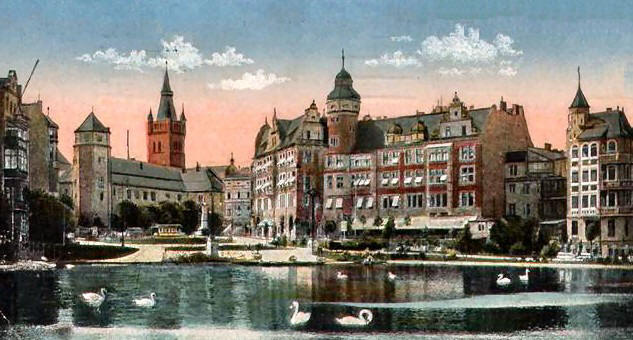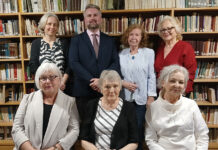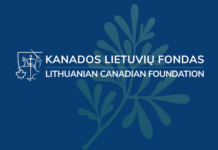
The Old Prussians worshipped their ancestors Prutenis and Videvutis as the gods Urskaits and Izsvambrāts (translated – the Elder and his brother). These gods gave benediction to farming, especially livestock and poultry. The Old Prussians put up stone images of Urskaits and Izsvambrāts to mark the borders of their lands.
The richness of “the amber lands” and their favourable position for trade on the Baltic Sea had long tempted unwelcome, armed visitors. In the middle of the 1st century CE, a conflict began between the Old Prussians and their southern neighbours – the Eastern Slav tribe called the Masurians or Mazovians (mozūrai in Lithuanian). The Masurian princes had tried to force the Old Prussians to acknowledge them as masters and pay regular tributes to them. But the Prussians held firm to Prutenis’ order to be loyal to their gods and their freedom. In the 7th century they routed an army made up soldiers of the Eastern Slavs and the powerful nomadic Turkic tribe the Avars. Some time after that the Masurian prince himself made a sacrifice to the Old Prussian gods at Romuva. Among the Avar troops were many Prussian youths who had been captured while children during previous attacks on the Prussian lands. Before the decisive battle, they crossed over to their compatriots’ side, bringing with them a valuable new acquisition – the Avars’ knowledge of horseback warfare.

The Old Prussian lands were partly protected from Eastern Slav attacks by forests and a network of marshes, but it was not possible to put obstacles up against the invaders who came in via the Baltic coastline – the Scandinavian Vikings, who had started arriving in their boats, in search of both trade and plunder. There is a Scandinavian graveyard on the Semba peninsula by the village of Vīskautena, indicating that for quite a long time there was a Viking settlement there. Many attacks on Semba by Danish Vikings are recorded in 12th-century chronicles, although these attacks did not particularly threaten the independence of the Old Prussians, because their aim was plunder, not conquering territory.
After the Principality of Masuria joined the Kingdom of Poland, the Polish leader repeatedly tried to subjugate the Old Prussians as well. In the second half of the 10th century, Poland adopted Christianity. King Bolesław the Brave was the first to attempt to convert the Old Prussian lands to Christianity. With his support, in 997 the first missionary arrived – Adalbert, the Bishop of Prague. The Old Prussians realized that converting to Christianity could threaten their independence; they urged Adalbert to leave their land, but he did not obey and was killed. Before long Adalbert was made a saint, and depictions of his life made the word Prussian more widely known in medieval Europe.
During the 12th century and at the start of the 13th century, the Old Prussians experienced repeated invasions from Polish armies. In 1218, the Pope declared a holy war against the Prussians, and crusaders from all over Europe joined the Polish army. At first their numbers were not particularly large, and so the Old Prussians managed to successfully repel their attacks.
The situation changed in 1226, when the Prince of Masuria, Konrad, summoned the Teutonic Knights to help him in his fight against the Old Prussians. The knights had been “unemployed” after the crusaders’ were expelled from Palestine. As repayment for their assistance, Konrad offered the Order the region of Kulma, which Poland had conquered. In that same year, the Holy Roman Emperor, Friedrich II, assigned the Old Prussian lands to the Order, and gave them the authority to subdue the inhabitants. The German knights tried as hard as possible to break deep into the interior of the Prussian lands; once there, they built castles, whose garrisons would regularly destroy surrounding villages and countryside in order to force the Old Prussians to convert to Christianity and recognize the authority of the Order. Despite tenacious resistance from the Old Prussians, the military strength was on the side of the Order, because they were helped by the armed forces of all of Europe. Increasing numbers of leaders went to the aid of the Order at difficult moments, hoping to find fame as Christian knights and for rich spoils of war. In 1255, the Czech king Ottokar II travelled with a large army to Semba through the Old Prussians’ southern regions. He took the Sembian castle Tvangste by the mouth of the River Priegle, and there he built a fortress, which later would become known as Königsberg (“king’s hill” in German; Karaliaučius in Lithuanian, now the city of Kaliningrad, belonging to Russia).
The Old Prussians’ resistance against the crusaders was also hindered by a lack of internal unity. For a long time the different regions could not join together against a common enemy, and the Order also managed to get many Old Prussian nobles over to their side, allocating them the largest plots of land and thus preserving the nobles’ high social status even after Christianization. The knights welcomed the nobles and the Prussians of lower status into their brotherhood, and they loyally served the Order. A register of the brothers of the Livonian Order from the 15th century includes seven Old Prussian names.
A number of peace treaties and truces were concluded between the Order and the Old Prussians, but the Old Prussians repeatedly took opportunities to rise up. A general Prussian rebellion started in 1260, after the German crusaders’ defeat at the Battle of Durbe. Old Prussians in the different regions chose military leaders and began coordinated acts of war. Many castles, which were significant points of support for the Order, were taken.



























